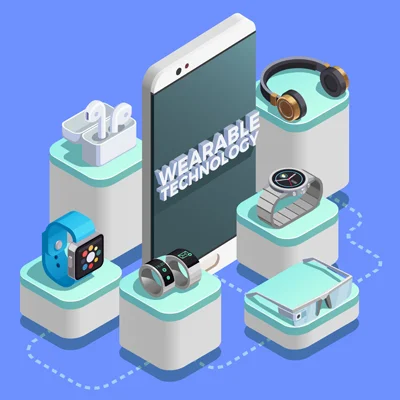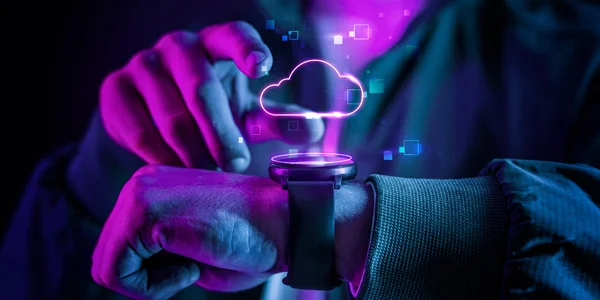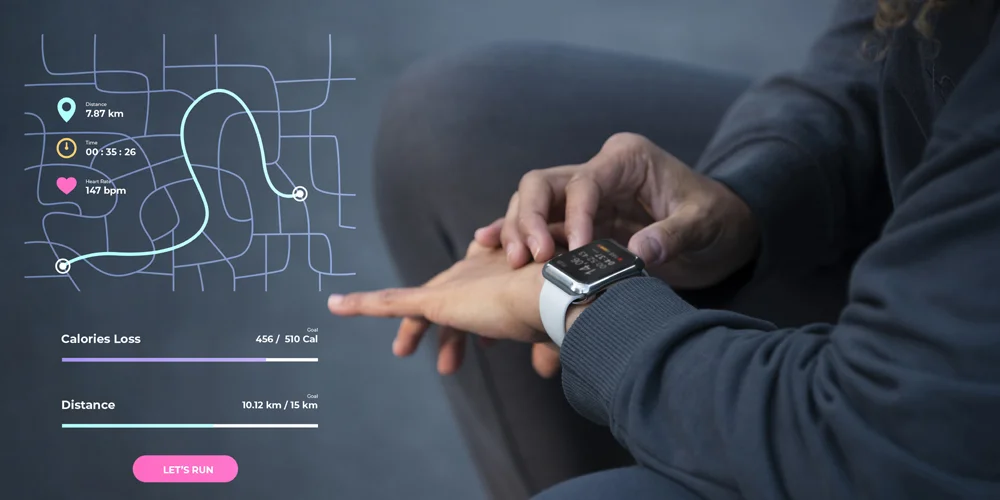Wearable Technology: often referred to as wearables, is a category of electronic devices and accessories that are designed to be worn on the human body, typically as clothing or accessories. These devices are equipped with sensors, connectivity features, and sometimes computing capabilities to collect and transmit data, perform tasks, or provide information to the user. Wearable technology is designed to seamlessly integrate into the user’s daily life, offering convenience, functionality, and often health or fitness monitoring. Common examples of wearable technology include smartwatches, fitness trackers, augmented reality (AR) glasses, and even smart clothing with embedded sensors.
History of Wearable Technology
The history of wearable technology is a fascinating journey that spans centuries, from rudimentary early forms to the high-tech devices we know today.
Here’s a chronological overview of the history of wearable technology:
- Abacus Ring (17th Century): An early example of wearable technology is the abacus ring used in China during the 17th century. This ring had a small abacus mounted on it, allowing wearers to perform basic arithmetic calculations on the go.
- Pocket Watches (16th Century): Pocket watches, developed in the 16th century, can be considered one of the earliest forms of wearable technology. They were primarily used for timekeeping but became increasingly sophisticated over time.
- Pedometers (18th Century): Thomas Jefferson is credited with inventing an early pedometer, known as a “waywiser.” This device measured the distance a person had traveled by counting steps, making it one of the first fitness-related wearables.
- Wristwatches (Late 19th Century): The transition from pocket watches to wristwatches in the late 19th century made timekeeping more convenient and marked the beginning of wrist-worn technology.
- Hearing Aids (20th Century): The development of hearing aids in the 20th century improved the quality of life for those with hearing impairments. These devices can be considered early wearable technology designed for health and wellness.
- Digital Watches (1970s): The 1970s saw the introduction of digital watches, which displayed time in a digital format rather than using traditional watch hands. These watches, such as the Pulsar LED watch, were seen as cutting-edge technology.
- Calculator Watches (1970s): In the mid-1970s, calculator watches like the Pulsar Calculator Watch emerged, allowing users to perform basic mathematical calculations on their wrist.
- Wrist Computers (1980s): The Seiko UC-2000 wrist computer, introduced in the 1980s, featured data storage and basic computing functions. It was one of the early attempts at a wearable computer.
- Bluetooth Headsets (2000s): Bluetooth headsets, such as the Motorola RAZRWear, became popular for hands-free communication with mobile phones. These devices marked a significant step in the evolution of wearable tech for communication.
- Fitness Trackers (2010s): The 2010s witnessed the rise of fitness trackers like Fitbit, designed to monitor physical activity, heart rate, and sleep patterns. They gained widespread popularity for promoting a healthier lifestyle.
- Smartwatches (2010s): The introduction of smartwatches, notably the Apple Watch in 2015, marked a turning point in the wearable tech industry. These devices combined smartphone connectivity with health tracking and app functionality, providing a versatile and multifunctional platform.
- Augmented Reality (AR) and Virtual Reality (VR) Headsets (2010s): The 2010s also saw advancements in AR glasses, VR headsets, and smart eyewear, such as Google Glass and Oculus Rift, designed for immersive experiences, information overlay, and entertainment.
- Smart Clothing (2010s): Smart clothing embedded with sensors and technology for various applications, including health monitoring and sports performance, gained attention in the latter part of the 2010s.
The history of wearable technology demonstrates the ongoing convergence of technology and fashion, with innovations that aim to seamlessly integrate technology into our daily lives while serving various practical and entertainment purposes. As technology continues to advance, it’s likely that wearable technology will become even more integrated and sophisticated in the future.

Types of Wearable Technology
Wearable technology encompasses a wide range of devices designed to be worn on the body. These devices vary in form, function, and application.
Here are some common types of wearable technology:
- Smartwatches: Smartwatches are wrist-worn devices that connect to smartphones and offer features like notifications, apps, fitness tracking, and often include touchscreens.
- Fitness Trackers: Fitness trackers, or activity trackers, are typically wrist-worn devices designed to monitor physical activity, including steps taken, heart rate, sleep patterns, and more.
- Smart Glasses: Smart glasses, such as Google Glass, provide a heads-up display, allowing users to access information, take pictures, and interact with data using voice commands or touch gestures.
- Hearables: Hearables are wireless earbuds or headphones that often have additional features, including fitness tracking, health monitoring, and voice assistance.
- Smart Rings: These are compact rings equipped with sensors and can connect to smartphones to display notifications, track activity, and provide access to certain features.
- Smart Clothing: Smart clothing includes garments embedded with sensors and technology for purposes like health monitoring, fitness tracking, and posture correction.
- Smart Jewelry: These are pieces of jewelry, such as necklaces or bracelets, that incorporate technology to monitor various aspects of health or provide notifications discreetly.
- Health and Medical Wearables: Medical wearables can monitor vital signs, deliver medication, or assist people with chronic health conditions. Examples include continuous glucose monitors and wearable defibrillators.
- Wearable Cameras: Devices like body cameras or clip-on cameras can be worn to capture photos and videos while on the move.
- Wearable GPS Devices: These are typically wrist-worn devices for outdoor enthusiasts, hikers, and runners to track their location and activities using GPS technology.
- Smart Shoes: Some shoes have sensors embedded to provide data about a person’s gait, activity, and posture, which can be helpful for athletes and individuals with mobility concerns.
- Wearable Keyboards: Small, finger-worn devices can project a virtual keyboard onto a surface, allowing users to type without a physical keyboard.
- Wearable Gaming Devices: Gaming-focused wearables, such as VR headsets and haptic feedback devices, enhance the gaming experience.
- Wearable E-Textiles: These are textiles and fabrics embedded with electronics and sensors for applications ranging from fashion to medical monitoring.
- Augmented Reality (AR) and Virtual Reality (VR) Headsets: While not worn on a daily basis, AR and VR headsets are worn on the head to provide immersive digital experiences.
- Body-Worn Cameras: Law enforcement, security personnel, and individuals may wear body cameras to record events and encounters.
- Wearable Technology for Pets: Some wearables are designed for animals, including GPS trackers, health monitors, and pet fitness trackers.
The field of wearable technology continues to evolve, with new innovations and categories emerging regularly. These devices often aim to provide convenience, improve health and fitness, enhance productivity, or offer unique experiences. The diversity of wearable technology types demonstrates the growing integration of technology into our daily lives and the potential for future developments.
Features of Wearable Technology
Wearable technology comes in various forms, and the features of these devices can vary widely depending on their intended purpose and design.
However, there are several common features and capabilities found in many wearable technology devices:
- Sensors: Wearable devices are often equipped with a variety of sensors, such as accelerometers, gyroscopes, magnetometers, heart rate monitors, GPS, ambient light sensors, and more. These sensors collect data about the wearer and their environment.
- Connectivity: Most wearables can connect to other devices, such as smartphones, tablets, or computers, via Bluetooth, Wi-Fi, or cellular data connections. This connectivity allows for data transfer, synchronization, and remote control.
- Display: Some wearables have built-in displays, often in the form of a touchscreen, to provide information, notifications, or visual feedback to the user. Others rely on LED indicators or even augmented reality displays.
- Health and Fitness Monitoring: Many wearables are designed for health and fitness tracking. They can monitor metrics like steps taken, distance traveled, heart rate, sleep patterns, and more. They may also offer features like workout tracking and calorie counting.
- Notifications: Wearables often provide real-time notifications for calls, messages, emails, social media updates, and app alerts. Users can receive and respond to notifications directly from their wearable devices.
- Voice Control: Voice assistants like Siri, Google Assistant, and Alexa are integrated into many wearables, enabling users to perform tasks and get information using voice commands.
- GPS and Location Services: Some wearables, especially those designed for sports and outdoor activities, feature GPS capabilities for tracking location, mapping, and navigation.
- Water Resistance: Many fitness trackers and smartwatches are designed to be water-resistant or even waterproof to withstand exposure to sweat, rain, and, in some cases, underwater use.
- App Ecosystem: Smartwatches and certain other wearables support third-party apps. Users can install and run various applications on their devices to extend functionality.
- Music Control: Some wearables allow users to control music playback on their smartphones or have onboard music storage for standalone listening. They may include features like music playback, volume control, and playlist selection.
- Battery Life: Battery life can vary widely among wearables, with some lasting for a day or two on a single charge, while others can go for weeks without needing to recharge.
- Gesture Control: A few wearables offer gesture recognition capabilities, allowing users to control the device through specific hand movements or gestures.
- Payments: Some wearables, like smartwatches and fitness bands, support mobile payment solutions, enabling users to make contactless payments.
- Emergency Features: Certain wearables include safety features like SOS buttons or fall detection to alert emergency contacts or services in case of an emergency.
- Customization: Many wearables allow users to customize watch faces, straps, and settings to personalize their device to their preferences.
- Data Synchronization: Data collected by wearables can be synchronized with companion apps or cloud services for long-term tracking, analysis, and sharing with healthcare providers or friends.
The specific features of a wearable device depend on its intended use case, whether it’s a smartwatch, fitness tracker, AR glasses, or other types of wearables. As technology continues to advance, wearables will likely continue to offer more features and capabilities to meet the evolving needs of users.
Benefits of Wearable Technology
Wearable technology offers a wide range of benefits across various aspects of life, from health and fitness to convenience and productivity.
Here are some of the key benefits of wearable technology:
- Health and Fitness Monitoring: Wearable devices like fitness trackers and smartwatches can monitor various health metrics, including heart rate, sleep patterns, steps taken, and calories burned. This data helps users stay informed about their health and make informed decisions about their lifestyle.
- Motivation and Accountability: Wearable devices can motivate users to lead a healthier lifestyle by setting goals and providing real-time feedback. The gamification aspect, such as achieving daily step goals or competing with friends, can be highly motivating.
- Convenience: Wearables offer convenience by providing easy access to information, notifications, and apps directly from the wrist or body. Users can check messages, control music, and access important information without needing to take out their smartphones.
- Hands-Free Communication: Devices like smartwatches and hearables offer hands-free communication, allowing users to make and receive calls, send messages, and use voice assistants without physically handling their phones.
- Productivity: Smartwatches and AR glasses can enhance productivity by providing quick access to calendar reminders, email alerts, and task lists, streamlining work and personal organization.
- Navigation: Wearable GPS devices and smart glasses with navigation capabilities assist users with real-time directions, maps, and location-based information, making them useful for outdoor activities and travel.
- Safety and Emergency Features: Some wearables have built-in safety features, such as SOS buttons, fall detection, and location sharing, which can be invaluable in emergency situations.
- Entertainment: Wearable technology, including VR headsets and smart glasses, offers immersive entertainment experiences, such as virtual reality gaming, watching 360-degree videos, or enjoying augmented reality applications.
- Wearable Payments: Wearables with payment capabilities allow users to make secure, contactless transactions at compatible point-of-sale terminals, making shopping and dining more convenient.
- Monitoring and Feedback: Wearables can provide real-time feedback and suggestions for improving various aspects of life, from fitness to sleep quality, helping users make positive changes.
- Customization: Users can personalize the appearance and functionality of many wearables through custom watch faces, straps, and app selections to match their style and preferences.
- Tracking and Data Analysis: Wearable technology enables long-term tracking of health and activity data, which can be useful for making data-driven decisions, setting goals, and sharing information with healthcare professionals.
- Augmented Reality (AR): AR wearables, like smart glasses, can overlay digital information and visuals onto the real world, enhancing learning, training, and work applications.
- Fashion and Style: Many wearables are designed with aesthetics in mind, allowing users to express their style while benefiting from technology.
- Time Efficiency: Wearables reduce the need to constantly check a smartphone, saving time and making users more efficient in their daily tasks.
The benefits of wearable technology are diverse and continually expanding as new innovations and applications are developed. These devices have the potential to improve various aspects of daily life, promote healthier habits, and enhance the overall user experience.

Do wearable improve health?
Wearable technology, such as fitness trackers and smartwatches, has the potential to improve health in several ways. However, the extent to which wearables can positively impact health depends on individual use, goals, and how effectively the user integrates the technology into their lifestyle.
Here are some ways in which wearables can contribute to better health:
- Physical Activity Monitoring: Many wearables track the number of steps taken, distance traveled, and calories burned, which can encourage users to be more physically active. This data can motivate individuals to meet recommended daily activity levels, promoting cardiovascular health and reducing the risk of chronic diseases like heart disease and diabetes.
- Heart Rate Monitoring: Wearables with heart rate monitors can provide insights into cardiovascular health and help users identify irregularities or trends in heart rate. This can be particularly beneficial for those with heart conditions or individuals interested in optimizing their fitness.
- Sleep Tracking: Sleep tracking features in wearables can provide information about the quality and duration of sleep. Users can use this data to make adjustments to their sleep habits, potentially improving overall health and well-being.
- Stress Management: Some wearables offer stress monitoring features, including heart rate variability analysis. These can help users recognize and manage stress levels, which, if left unaddressed, can lead to various health issues.
- Nutrition Tracking: Certain wearables and accompanying apps allow users to log their food intake and track their nutritional habits, aiding in weight management and healthy eating.
- Goal Setting and Motivation: Wearables often allow users to set fitness and health goals. Meeting these goals can be motivating and encourage individuals to adopt healthier habits.
- Community and Social Support: Many wearables have social features, enabling users to connect with friends and family to challenge and support one another in achieving fitness and health goals.
- Medication Reminders: Some wearables can provide medication reminders, helping individuals stay on top of their prescription regimens, especially useful for those with chronic conditions.
- Fall Detection and Safety: Certain wearables, especially those designed for the elderly, have fall detection features and emergency alert buttons to ensure safety and prompt medical assistance if needed.
- Emergency Health Information: Some wearables store medical information and emergency contacts, which can be accessed in critical situations.
While wearables can provide valuable health information and motivation, their effectiveness ultimately depends on user engagement and willingness to act on the data provided. Wearables should be used as part of a broader health and wellness plan, and users should consult with healthcare professionals when making significant changes to their health routines. It’s also important to choose wearables with accurate sensors and features that align with one’s health goals.
What is the role of wearables?
Wearables play several important roles in various aspects of our lives. Their roles extend beyond mere fashion statements or gadgetry; they serve practical functions that benefit individuals in different ways.
Here are some key roles of wearables:
- Health and Fitness Monitoring: One of the primary roles of wearables is to monitor health and fitness. Devices like fitness trackers and smartwatches can track steps taken, heart rate, sleep patterns, and more, helping individuals maintain a healthy lifestyle.
- Convenience and Accessibility: Wearables provide easy and quick access to information, notifications, and apps. This can enhance convenience and accessibility, especially when users can check messages, control music, or receive alerts without pulling out their smartphones.
- Hands-Free Communication: Wearables, such as smartwatches and hearables, facilitate hands-free communication. Users can make and receive calls, send messages, and interact with voice assistants without handling their phones.
- Productivity: Some wearables, like smartwatches and AR glasses, boost productivity by offering access to calendar reminders, emails, and task lists. This can be particularly useful for organizing work and personal tasks.
- Navigation and Location Services: Wearable GPS devices and smart glasses with navigation features provide real-time directions, maps, and location-based information. This aids users in outdoor activities and travel.
- Safety and Emergency Assistance: Certain wearables have built-in safety features, such as SOS buttons and fall detection, which can be vital in emergency situations. They enable users to seek help quickly when needed.
- Entertainment: Wearable technology, including VR headsets and smart glasses, offers immersive entertainment experiences like virtual reality gaming, 360-degree videos, and augmented reality applications.
- Payment: Wearables with payment capabilities allow users to make secure, contactless transactions at compatible point-of-sale terminals, simplifying shopping and dining experiences.
- Monitoring and Feedback: Wearables offer real-time feedback and suggestions for improving different aspects of life, from fitness and sleep quality to overall well-being.
- Customization and Personalization: Users can personalize the appearance and functionality of many wearables, including customizing watch faces, straps, and app selections to match their individual style and preferences.
- Augmented Reality (AR): AR wearables, such as smart glasses, overlay digital information and visuals onto the real world, enhancing learning, training, and work applications.
- Fashion and Style: Wearables are often designed with aesthetics in mind, allowing users to express their personal style while benefiting from technology.
- Time Efficiency: Wearables reduce the need to continually check a smartphone, saving time and making users more efficient in their daily tasks.
- EnvironmentalandSocialImpact: Some wearables are designed with eco-friendliness and sustainability in mind, promoting responsible consumer choices.
- Data Collection and Research: Wearables can be used to collect data for research and scientific purposes, contributing to advancements in various fields, including health, sports, and human behavior.
The role of wearables is continually evolving as technology advances and new use cases emerge. Wearables have the potential to improve various aspects of daily life, promote healthier habits, and enhance the overall user experience.
Internet of Things: (IoT) Benefits & Building The Urban Future





